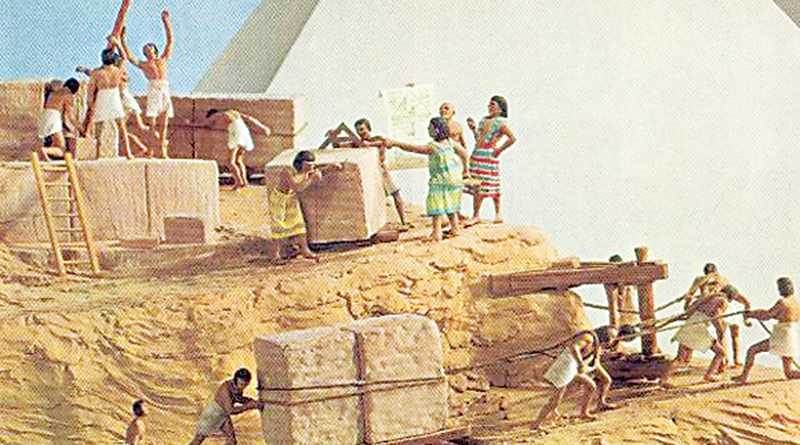Keeping Things Level Over Time ~ The History of Ordinary Things

How did early builders ensure the structures they were erecting were plumb vertically and horizontally? The principle they had observed is that a body of water is always horizontal, thus, a trough or channel filled with water can show horizontality.
When the pyramids were built as far back as 1100 B.C., Egyptians used boards with holes bored in them filled with water. If the water slopped over when they laid the board on a surface, they could judge which way the surface pitched.
It is known that by 100 B.C., the Romans used water filled tanks as primitive levels when building their aqueducts. By studying the water surface mode in the tank, the Romans could determine if the bases were flat or at an angle. Around the same time, builders also used an A-frame level, on which a plumb line (verticality) was suspended from the vertex of the A. The surface was horizontal if the plumb line bisected the crossbar of the A-frame.
The water level, introduced in the 1600s, was made of two glass cylinders connected by a tube. The hose level, first described in 1629, consisted of a length of hose fitted with an upright glass tube at each end. When the water in each tube was at the same height, the surface was level.
In 1661, a French inventor, Thevenot, created the spirit level, also called a bubble level. He used a straight sealed glass tube containing water and an air bubble. A spirit level will indicate how parallel (level) or perpendicular (plumb) a surface is relative to the earth.
In time, the water was replaced by alcohol or other spirits to prevent freezing thus giving the spirit level its name. In time it became evident that the spirit level’s accuracy could be increased by introducing curvature to its glass tube. Still later, the straight tube was replaced with a slightly bent one to reduce the erratic movement of the bubble.
In 1771, the circular level using a bubble floating within a circular glass indicated level in all directions. By the late 1800s, levels were made of wood and aluminum, in addition to cast iron.
Today, the spirit level containing alcohol or oil is the standard because it can indicate both plumb and level lines. The vial on both ends allows the user to grab it from either end for a quick level check.
In the mid-1980s, battery-powered electronic levels were introduced. Using a conductive liquid, a sensor and semiconductor chip read whether a surface is level or plumb. The level’s display panel indicates the direction of deviation. When plumb, the level issues a symbol on the display, a flashing light, or an audible signal. In 1989, a new digital level was introduced which measures degree, percent slope, pitch, plumb and level.
The simple principle that water remains horizonal will continue to direct the development of levels long into the future.
- Rain & Shine, A Millennia Of Innovation: The History of Ordinary Things - July 19, 2024
- Crayons Through The Ages ~ The History of Ordinary Things - June 21, 2024
- The Rocking Chair Revolution ~ The History of Ordinary Things - May 24, 2024


